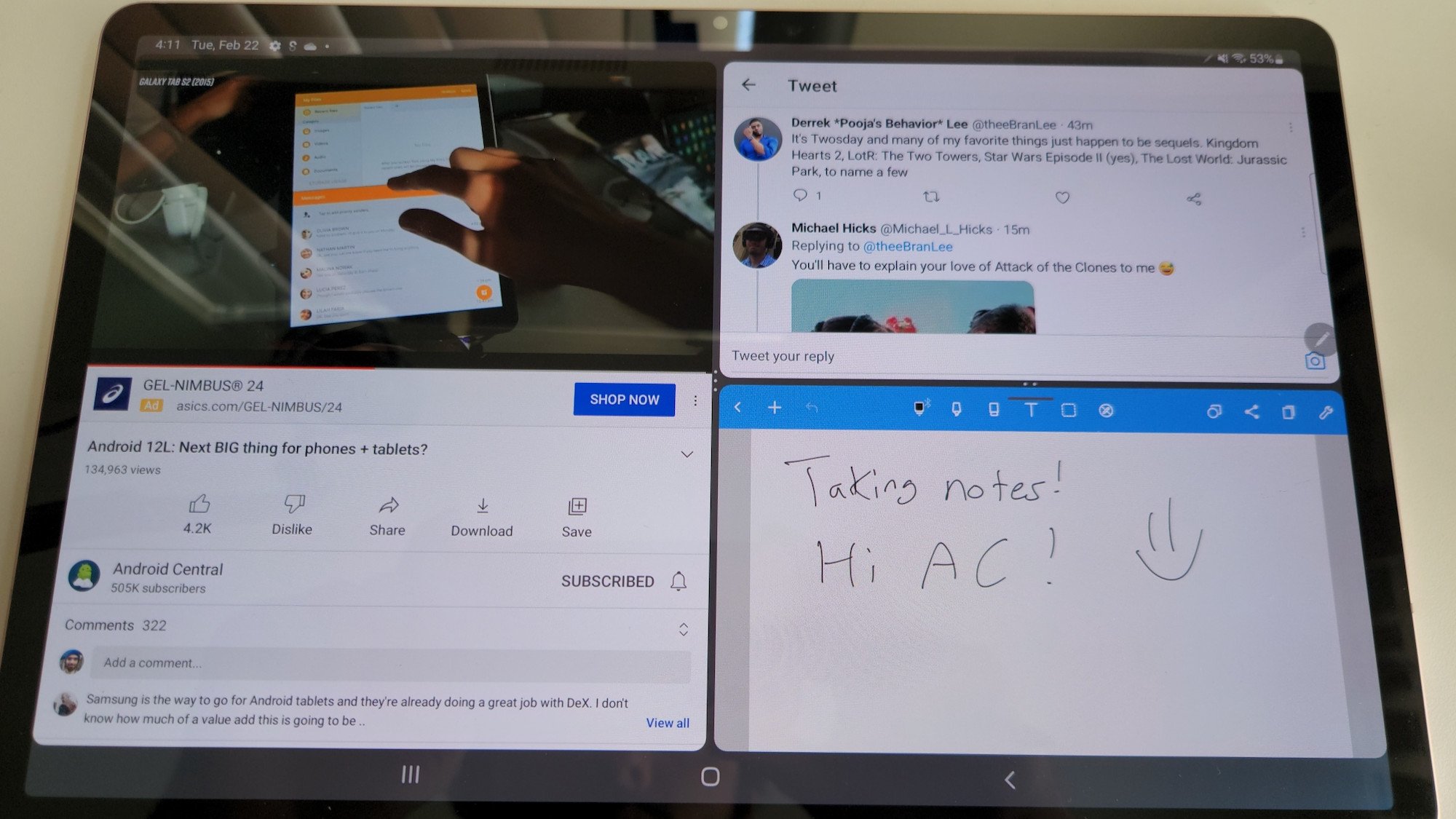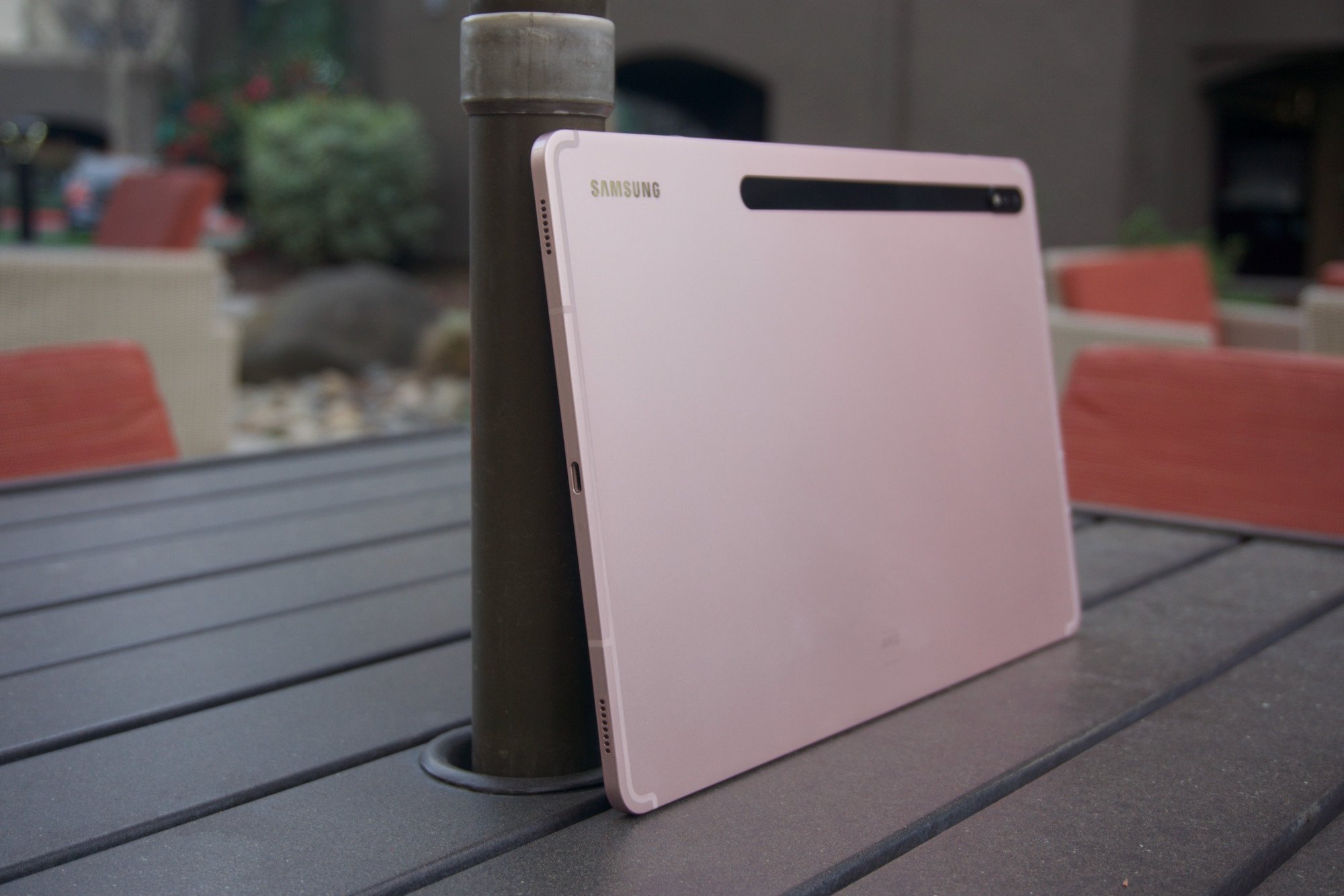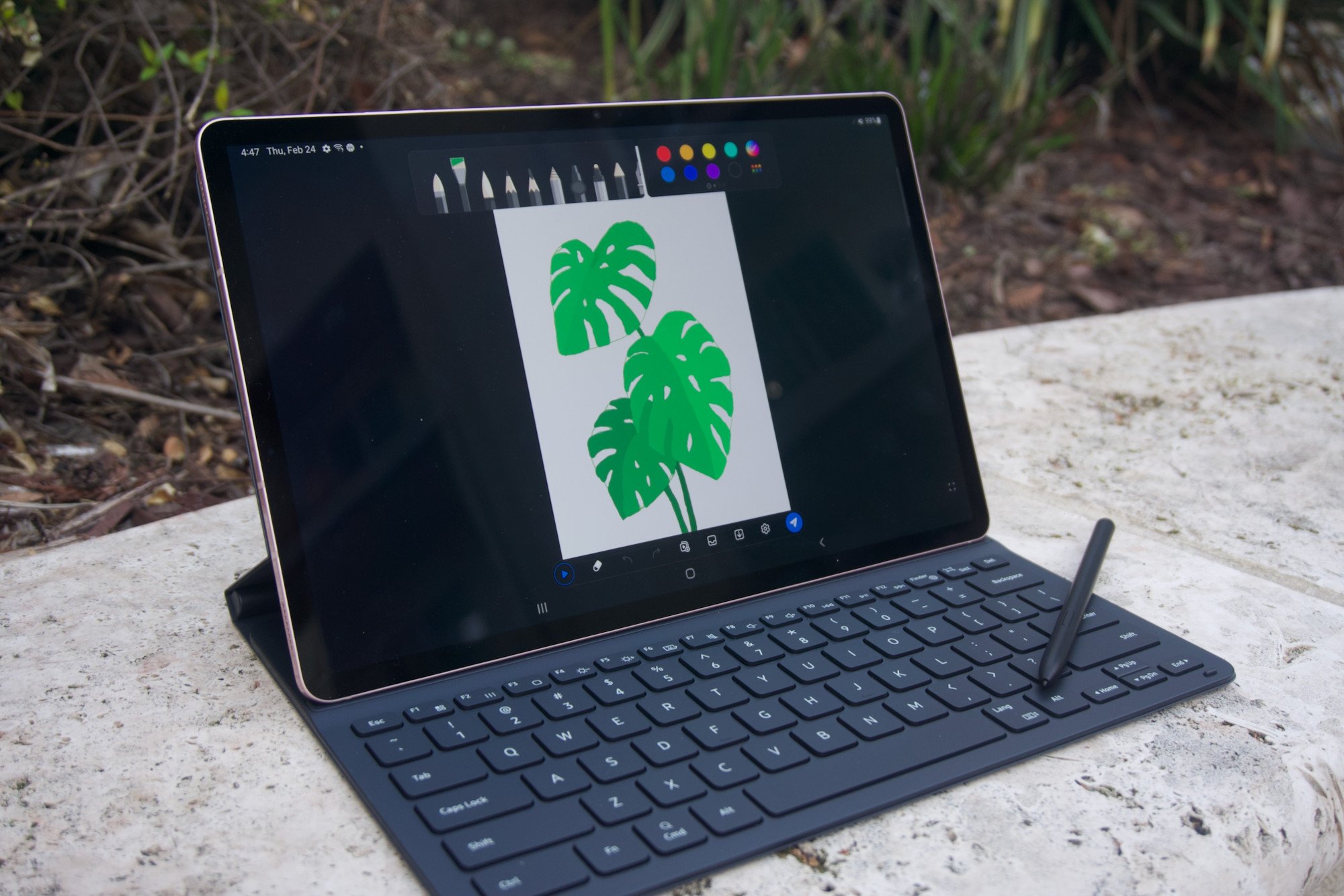Near-perfect hardware and revamped multi-app software almost make up for the unoptimized apps.
When we reviewed the Galaxy Tab S7+ in mid-2020, it arrived on the heels of years of Android tablet neglect by Google and most app developers. A perfect display, svelte design, and fast performance couldn't offset the fact that most Android apps on tablets simply spread out like gas in an empty box, not doing anything with the extra space to make using a Tab better than using a phone.
With the Galaxy Tab S8+, Samsung brought back the last model's best features while improving on its weak points. Retaining the same design, display, and battery as before, the Tab S8+ added an upgraded processor, more base RAM, a wider selfie camera, and faster Wi-Fi connectivity. More importantly, Samsung took matters into its own hands with One UI 4, using the same software tools from its foldable phones to take better advantage of the 12.4 inches of display real estate.
For anyone interested in the Samsung Galaxy Tab S8+, the question isn't whether or not it's a fantastic device; the only competition it has for the title of best Android tablet is the Tab S8 and Tab S8 Ultra. The real question is whether you should justify the high price or set your sights lower.
Samsung Galaxy Tab S8+
Bottom line: The Galaxy Tab S8+ emulates the Galaxy Tab S7+ in its design while adding scratch-proof materials, faster connectivity with optional 5G, improved S Pen responsiveness, a vastly improved selfie camera, and game-changing software upgrades for using several apps at once. While somewhat tricky to hold, it's much lighter than the Tab S8 Ultra and iPad Pro while offering plenty of power. Just be prepared to buy a fast charger and keyboard cover on top of the high price.
The Good
- Thin, lightweight, scratch-resistant design
- Latest SoC with 8GB of RAM
- S Pen is better than ever
- One UI 4 is a game-changer
- Reliably long battery life
- Four OS updates / security through 2027
The Bad
- Expensive
- No charger or cover in box
- Not compact enough for some people
- Most Android apps are still unoptimized
$900 at Samsung $900 at Amazon $900 at Best Buy
Samsung Galaxy Tab S8+: Price and availability
The Samsung Galaxy Tab S8+ costs $900 for the standard 8GB/128GB variant and comes in three colors: Graphite, Silver, or Pink Gold. The 8GB/256GB variant is priced at $980, while the 5G-enabled Tab S8+ costs $1,100 and is restricted to 128GB — though you can augment your storage with the 1TB microSD card slot. Currently, Samsung only has a Verizon 5G tablet available, but it promises to release T-Mobile and AT&T variants soon.
Samsung announced the Galaxy Tab S8 series on February 9 at its Unpacked event alongside the Galaxy Tab S8 and S8 Ultra, which cost $200 less and more, respectively. All three tablets shipped on February 25.
Samsung Galaxy Tab S8+: What you'll love
Before we delve into the new improvements with Samsung's latest Plus-sized tablet, we have to retread on the areas where Samsung stuck to the same winning formula as the Tab S7+. While not much has changed with the display and design since 2020, I'm glad Samsung didn't mess with a good thing.
| Category | Galaxy Tab S8 Plus |
|---|---|
| Chipset | Snapdragon 8 Gen 1 |
| Display | 12.4-inch Super AMOLED (120Hz) 2800 x 1752 500 nits |
| Memory | 8GB |
| Storage | 128GB or 256GB |
| Rear Camera | 13MP AF + 6MP UW + Flash |
| Front Camera | 12MP UW |
| Battery | 10,090mAh Li-Ion 45W Fast Charging |
| Audio | Quad AKG Speakers + Dolby Atmos |
| Authentication | Face Unlock, on-display fingerprint scanner |
| Connectivity | WiFi 6E (6GHz) Bluetooth 5.2 USB-C 3.2 5G (Optional) |
| S Pen | ✔️, 2.8ms latency |
| microSD card slot | ✔️ (up to 1TB) |
| 3.5mm headphone jack | 🚫 |
| Dimensions | 11.22" x 7.28" x 0.22" |
| Weight | 1.27 lb |
| Colors | Graphite, Silver, Pink Gold |
The 12.4-inch, 2800x1752 resolution display with 120Hz refresh rate and 240Hz touch sampling remains the star of the show. Scrolling feels as smooth as silk — or less metaphorically, as smooth as you'd see on a much smaller smartphone touchscreen.
Compared to the 12.4-inch Galaxy Tab S7 FE I reviewed last year, the pixel density doesn't change much, but the LCD-to-AMOLED upgrade makes a world of difference for color fidelity. Particularly with HDR content, you'll enjoy rich colors and deeper blacks along with a smoother refresh rate. Matched up against cheaper, large-sized tablets, you'll notice far less blurring around small text or icons where the limited pixels obviously can't keep up with the stretched-out interface.
Not much has changed in terms of your basic Android tablet UI experience. Samsung and Google have the resources and inclination to optimize their apps for larger spaces. Otherwise, most popular apps either stretch out awkwardly over the 12.4-inches or sit as a column in the center with space on both sides. That's not great, obviously. But thanks to One UI 4, you can either slot apps next to one another in a 3-box configuration or place an app as a tiny pop-up above a full-screen app.
Android apps look terrible spread out across a tablet but perfectly natural in 4-6-inch chunks side-by-side with one another.
You could do this with Samsung DeX before, but many apps didn't resize properly. Switching between DeX and One UI was an annoying step, and it only really worked well on a desk with a Bluetooth mouse. Now that One UI 4 does this natively, it's as simple as grabbing the S Pen, swiping the small gray line out to reveal the pinned taskbar on the top-right, then drag-and-drop your favorite apps into whatever portion of the display you want.
The Galaxy Tab S7 and S7+ received One UI 4 in January, so you can take full advantage of these tools without buying a new tablet. But Samsung's last-gen Tabs came with 6GB of base RAM and the Snapdragon 865 — plenty of memory and processing power for a single app, but maybe not enough for three at once in 2022. Now you have the Snapdragon 8 Gen 1 and 8GB from jump; I've done my best to put the Tab S8+ through its paces and run demanding apps side-by-side, and so far, I haven't overtaxed the memory at all.
One UI 4 is just the start of Samsung's multitasking UI plans.
It's not a perfect system by any means. Opening a new app minimizes and saves your current app configuration in the taskbar, but I had moments when they decoupled for no reason, so I had to set things up all over again. I almost wish One UI defaulted to opening pop-up windows of apps when you're multitasking, or at least gave you a choice when you tap on the taskbar icon. Still, Samsung has promised to bring Android 12L updates later this year. Given Samsung has promised four OS updates through Android 16 and security updates through 2027, you can rest assured it'll have a long shelf life and that these One UI improvements are just the start.
Design-wise, the Galaxy Tab S8+ barely changed from the Tab S7+. It weighs and measures the same down to the millimeter and gram. Its 16:10 aspect ratio has some drawbacks compared to the 4:3 iPad Pro design, but it's the perfect layout for streaming your favorite films and shows. Also, when it comes to using it in portrait mode, the narrower width makes it easier to grip firmly along the edge with the S Pen in the other hand. Whereas the wider iPad Pro (or the Tab S8+ in landscape) requires what I call the waiter/tray method of holding it, which is more prone to drops.
You get the same quad AKG-tuned speakers as before, so the sound quality stays rich and clear no matter how you orient it or how high you pump the volume. As Hayato said about the S7+ in his review, it's genuinely impressive how Samsung brought superb audio quality to such a thin device.
Where Samsung improved is with its S Pen support. The Galaxy Tab S7+ has a 9ms latency, crushing the S7 and its 26ms latency. Now, the Tab S8+ merely has a 2.8ms delay — the same as the Galaxy S22 Ultra despite the much larger display, and so short that your brain really can't perceive it. While taking notes, you can freely write without the distraction of your strokes taking too long to materialize.
Samsung has several first- and third-party note-taking and drawing apps installed when you unbox it. I mostly stuck to Samsung Notes (and installed Google Docs) to use as pop-up windows on top of Google Meet calls with colleagues or streaming a D&D podcast. But my partner gravitated towards Penup, a digital drawing app that lets you follow along with video tutorials and recreate artists' work. And she said the S Pen and software felt much more responsive than on her iPad Pro, though she couldn't fully accustom herself to the tablet's weight.
Samsung upgraded S Pen speeds, camera quality, scratch protection, Wi-Fi speeds, and other fundamentals.
Another valuable upgrade for this day and age is the 12MP 120-degree selfie camera, a jump up from the 8MP 80-degree camera in the last generation. It ensures that you can set your tablet and keyboard cover on a flat surface and have your full room visible to the person on the other end, with the new Auto Framing tool to zoom in on whoever's speaking.
The battery capacity remains unchanged at 10,090mAh, which combined with the increased RAM and processing power means you're going to burn through the battery slightly faster than on the S7+. Despite that, I still saw somewhere between 9 and 12 hours of active screen time while juggling apps, and you'll barely notice any battery drain leaving it on overnight. Depending on how often you switch it on, it should last across a full day or two of use easily.
Lastly, while I don't personally own a Wi-Fi 6E router, the upgrade to 6E support will future-proof its browsing and downloading speeds for the next few years.
Samsung Galaxy Tab S8+: What you won't like
Along with the same upsides of the Galaxy Tab S7+, the Galaxy Tab S8+ has identical downsides. Its proportional weight-to-size ratio is lower than cheaper tablets because of the aluminum frame and 5.7mm-thick design, but it's still too heavy to comfortably hold in bed or the couch unless you rest it on something, like your stomach or lap. Plenty of people prefer 8-inch tablets they can hold close to their eyeballs, and until Samsung makes an iPad Mini-competing device, its S Tabs won't work for that demographic.
16:10 is a polarizing aspect ratio that limits the amount of multitasking you can do compared to 4:3.
While the Galaxy Tab S8+ has the power and screen space for multitasking, the 16:10 aspect ratio makes some configurations untenable because of the limited vertical space. Placing one app atop the other in landscape makes both too squat to convey enough information because Android apps use vertical space better than horizontal space. If Samsung had gone with a 4:3 ratio, it would have made the tablet heavier and less comfortable, but also better prepared to handle more than just streaming movies.
And on that note, no matter how much I love the fresh multitasking tools, plenty of people will stick to one app at a time. And thanks to Google's neglect, most app developers don't bother with Android tablet optimization the way they do with iPadOS. Google recently promised to do right by Android tablets, but even if we believe that — and many of my colleagues don't — it may not solve this fundamental problem.
If you're spending $900 on a tablet, you should get a case and charger for that price.
Samsung continues to pretend that its slim keyboard cases are "accessories" instead of necessary tools that should be bundled in the box. You can use the Tab S8+ as a handheld device, but its best form factor is attached to a case with a keyboard so you can tap or type away unencumbered. And unless you got one as a preorder perk, you'll have to spend up to $160 on the official accessory. The same applies to buying a 45W charger since Samsung didn't bundle that either.
If you're spending $900 on a tablet, you should get a case and charger for that price, full stop.
Aside from those fundamental, recurring issues, most of my other complaints with the Galaxy Tab S8+ are more nitpicky than deal-breaking.
For example, I don't love the limited Galaxy Tab S8 color options. I like the Pink Gold model Samsung sent well enough, better than Graphite because it masks fingerprint smudges better, and my fingertips are as oily as they come. But I wish we could have seen the same colors we got with the Galaxy S22 Plus and Ultra like Green or Burgundy.
I will also continue fighting a losing battle and pine for a 3.5mm headphone jack. Yes, you can always use Bluetooth or USB-C headphones, but I prefer the simplest option I can rely on even when I'm charging my tablet.
And if you plan to buy the 5G version to use on the go, you may not be fully satisfied with its 500 nits maximum brightness. It works well enough indoors but isn't going to handle direct sunlight very well.
Samsung Galaxy Tab S8+: Competition
Samsung's strongest competition, as I already mentioned, is with itself. The Galaxy Tab S8 and S8 Ultra essentially offer the same performance, storage, battery life, audio quality, and display quality, but each has its strengths and weaknesses. Of the three, I'd argue the middle option wins the day.
The Tab S8, for instance, downgrades to an LCD with slightly higher S Pen latency but has higher brightness and an estimated two extra hours of battery life. You're spending $200 less for a tablet that's much more manageable to hold; on the other hand, less screen space means you're probably only going to open two apps at once before it gets too crowded, which in my mind limits its usefulness. It's a matter of preference, but I prefer to compromise on comfort instead of screen size.
On the opposite end, you'll find the absurdly large Galaxy Tab S8 Ultra with its 14.6-inch display, 90% screen-to-body ratio with tiny bezels, the option to upgrade to 12-16GB of RAM, and a polarizing notch housing the selfie cameras. Compared to the Tab S8+, it doesn't have many upsides apart from the extra screen space for multitasking, and at 1.6 pounds, it's truly a desk-only tablet that's not comfortable to hold for any length of time.
Honestly, Samsung's real competition is with Apple and the iPad Pro (2021). It weighs much more at 1.5lb. in exchange for much more vertical screen space via the 4:3 aspect ratio. They rival one another in pixels-per-inch, 12MP ultra-wide selfie cam that tracks movement, and four stereo speakers. Apple takes the lead, however, with its laptop-quality M1 chip, superior iPadOS app support, and up to 1,600 nits of peak brightness.
Samsung Galaxy Tab S8+: Should you buy it?
You should buy this if...
- You want a tablet for work, play, or both at the same time
- You've become spoiled by your 120Hz phone
- You need something portable for productivity
You shouldn't buy this if...
- You're on a limited budget
- You need a primary productivity device
- You're satisfied with your Galaxy Tab S7+
It's always tricky to determine who an Android tablet is for or what its purpose is. In the case of the Samsung Galaxy Tab S8+, it's for anyone who can afford the high price tag, has a short attention span only satisfied by using multiple apps at once, and wants a powerful-yet-portable device that'd work well on a student's small desk or an airplane tray.
But despite its many perks, I'd still categorize the Tab S8+ as a secondary device, not a laptop-replacing one. That'll limit its reach to people with a high discretionary income who want a premium tablet in addition to a premium phone and laptop. But as a device that'll receive support for five years, it should justify the cost over time.
Thanks to the expansive display, fast refresh rate, and flagship power, the Tab S8+ is essentially designed for multitasking. You can split your laptop display with multiple windows, but thanks to the S Pen support and apps designed to reflow to fit smaller spaces, it's an entirely new experience with One UI. And more multitasking improvements should arrive via Android 12L before the year is out.
Does that sound appealing? Then you won't have any regrets about buying the Tab S8+. You could also buy it for its powerful specs alone; you won't find 120Hz and QHD resolution on tablets very often, which makes streaming movies or gaming an absolute pleasure. But if you're not planning on keeping it on a desk very often, you'd probably want to choose the more compact Tab S8 instead. The Tab S8+ is designed for more rigorous use and is priced accordingly.
Samsung Galaxy Tab S8+
Bottom line: If you're going to buy a premium Android tablet for note-taking, productivity, video calls, streaming, or whatever else you need in a multitasking device, make it the Galaxy Tab S8+. It's the one model that hits the right balance between size and comfort.














Tidak ada komentar:
Posting Komentar